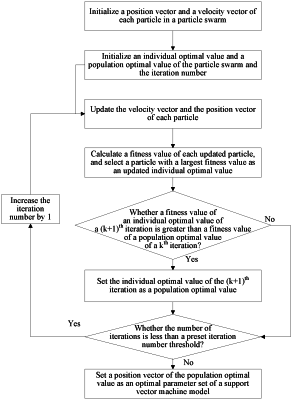| CPC G06N 20/10 (2019.01) [G06N 3/006 (2013.01); G06N 20/00 (2019.01)] | 6 Claims |

|
4. A prediction system of high slope deformation, the predicting system comprising:
at least one processor; and
a memory storing instructions that, when executed by the at least one processor, cause the at least one processor to execute operations comprising:
obtaining historical deformation data of each period of each part of a high slope as sample data;
dividing the sample data into training samples and test samples;
establishing a Support Vector Machine (SVM) model by using a radial basis function as a kernel function;
optimizing a parameter group of the SVM model by using the training samples and a Particle Swarm Optimization (PSO) algorithm to determine an optimal parameter group of the SVM model, to obtain a trained SVM model, further comprising:
initializing a position vector and a velocity vector of each particle in a particle swarm;
calculating a fitness value of each particle after initialization by using the training samples, and selecting a particle with a largest fitness value as an initial individual optimal value and an initial population optimal value, wherein the iteration number k is set to 0;
updating the velocity vector of each particle by using a formula Vik+1=wVik+c1r1(pk−xik)+c2r2(gk−xik), and update the position vector of each particle by using a formula xik+1=xik+vik+1, wherein
w is an inertia weight; i=1, 2, 3, . . . , N is a particle population size; xik and Vik respectively represent a position vector and a velocity vector of a kth iteration; xik+1 and Vik+1 respectively represent a position vector and a velocity vector of a (k+1)th iteration; k is the iteration number; pk represents a position vector of an individual optimal value of the kth iteration; gk represents a position vector of a population optimal value of the kth iteration; r1 and r2 respectively represent a first random number and a second random number in an interval of [0,1]; and c1 and c2 respectively represent a first learning factor and a second learning factor;
calculating a fitness value of each particle after updating by using the training samples, and select a particle with a largest fitness value as an updated individual optimal value;
determining whether a fitness value of an individual optimal value of the (k+1)th iteration is greater than a fitness value of the population optimal value of the kth iteration, to obtain a first determining result;
setting the individual optimal value of the (k+1)th iteration as a population optimal value if the first determining result indicates that the fitness value of the individual optimal value of the (k+1)th iteration is greater than the fitness value of the population optimal value of the kth iteration;
determining whether the iteration number is less than a preset iteration number threshold, to obtain a second determining result;
if the second determining result indicates that the iteration number is less than the preset iteration number threshold, increasing the iteration number by 1, and returning to the step of “updating the velocity vector of each particle by using a formula Vik+1=wVik+c1r1(pi−xik)+c2r2(gi−xik), and updating the position vector of each particle by using a formula xik+1=xik+vik+1”; and
setting a position vector of the population optimal value as the optimal parameter group of the SVM model if the second determining result indicates that the iteration number is not less than the preset iteration number threshold;
verifying, by using the test samples, whether an output error of the trained SVM model is less than a preset error threshold, to obtain a verification result;
re-determining an optimal parameter group of the SVM model by using the training samples and the PSO algorithm if the verification result indicates that the output error is not less than the preset error threshold, updating the trained SVM model with the re-determined optimal parameter group to execute the step of “verifying whether an output error of the trained SVM model is less than a preset error threshold by using the test samples, to obtain a verification result”; and
predicting the deformation of each area of the high slope in each period in the future by using the trained SVM model if the verification result indicates that the output error is less than the preset error threshold.
|